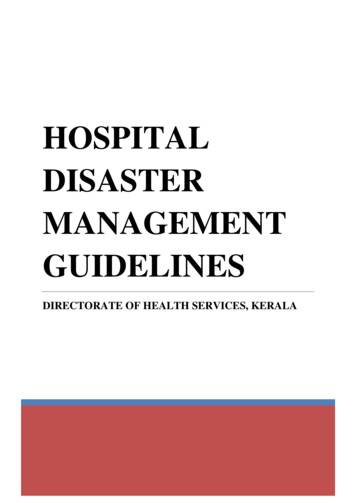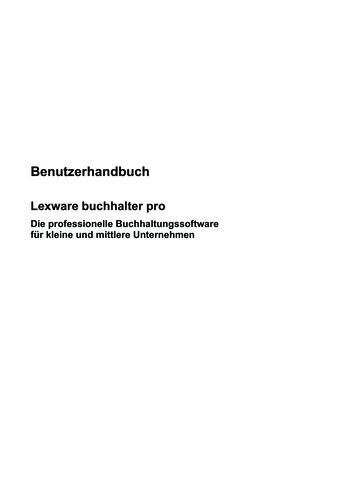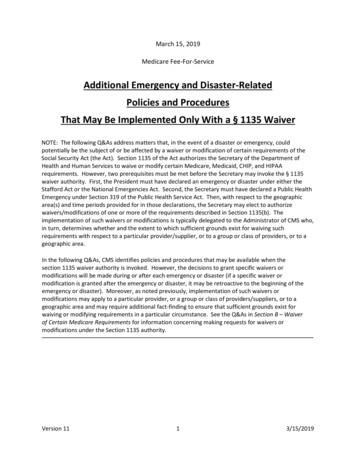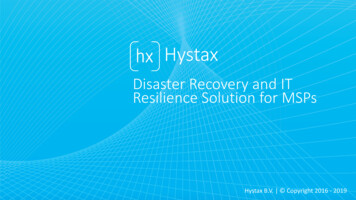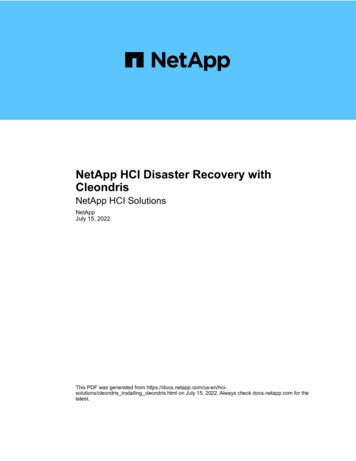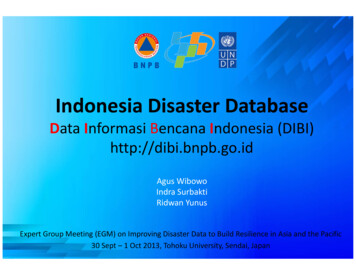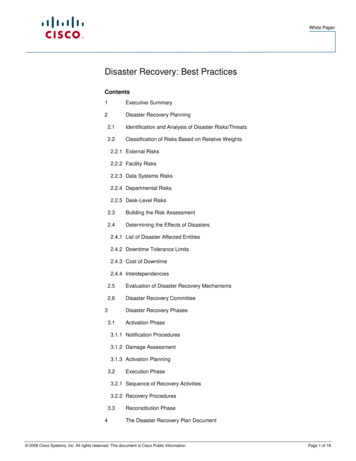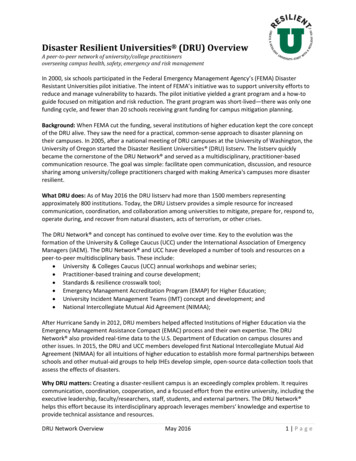
Transcription
Disaster Resilient Universities (DRU) OverviewA peer-to-peer network of university/college practitionersoverseeing campus health, safety, emergency and risk managementIn 2000, six schools participated in the Federal Emergency Management Agency’s (FEMA) DisasterResistant Universities pilot initiative. The intent of FEMA’s initiative was to support university efforts toreduce and manage vulnerability to hazards. The pilot initiative yielded a grant program and a how-toguide focused on mitigation and risk reduction. The grant program was short-lived—there was only onefunding cycle, and fewer than 20 schools receiving grant funding for campus mitigation planning.Background: When FEMA cut the funding, several institutions of higher education kept the core conceptof the DRU alive. They saw the need for a practical, common-sense approach to disaster planning ontheir campuses. In 2005, after a national meeting of DRU campuses at the University of Washington, theUniversity of Oregon started the Disaster Resilient Universities (DRU) listserv. The listserv quicklybecame the cornerstone of the DRU Network and served as a multidisciplinary, practitioner-basedcommunication resource. The goal was simple: facilitate open communication, discussion, and resourcesharing among university/college practitioners charged with making America's campuses more disasterresilient.What DRU does: As of May 2016 the DRU listserv had more than 1500 members representingapproximately 800 institutions. Today, the DRU Listserv provides a simple resource for increasedcommunication, coordination, and collaboration among universities to mitigate, prepare for, respond to,operate during, and recover from natural disasters, acts of terrorism, or other crises.The DRU Network and concept has continued to evolve over time. Key to the evolution was theformation of the University & College Caucus (UCC) under the International Association of EmergencyManagers (IAEM). The DRU Network and UCC have developed a number of tools and resources on apeer-to-peer multidisciplinary basis. These include: University & Colleges Caucus (UCC) annual workshops and webinar series; Practitioner-based training and course development; Standards & resilience crosswalk tool; Emergency Management Accreditation Program (EMAP) for Higher Education; University Incident Management Teams (IMT) concept and development; and National Intercollegiate Mutual Aid Agreement (NIMAA);After Hurricane Sandy in 2012, DRU members helped affected Institutions of Higher Education via theEmergency Management Assistance Compact (EMAC) process and their own expertise. The DRUNetwork also provided real-time data to the U.S. Department of Education on campus closures andother issues. In 2015, the DRU and UCC members developed first National Intercollegiate Mutual AidAgreement (NIMAA) for all intuitions of higher education to establish more formal partnerships betweenschools and other mutual-aid groups to help IHEs develop simple, open-source data-collection tools thatassess the effects of disasters.Why DRU matters: Creating a disaster-resilient campus is an exceedingly complex problem. It requirescommunication, coordination, cooperation, and a focused effort from the entire university, including theexecutive leadership, faculty/researchers, staff, students, and external partners. The DRU Network helps this effort because its interdisciplinary approach leverages members' knowledge and expertise toprovide technical assistance and resources.DRU Network OverviewMay 20161 Page
DRU and UCC Resources and Activities SummariesDisaster Resilient Universities (DRU) ilient-universitiesDRU's mission is to facilitate open communication, discussion, and resource-sharing amonguniversity/college practitioners charged with making campuses more disaster-resilient. Sharinginformation helps campuses mitigate, prepare for, respond to, operate during, and recover fromnatural disasters, acts of terrorism, or other crises.Disaster Resilient Universities (DRU) ListservThe DRU network has grown to over 1500 members at more than 800 institutions of highereducation. The University of Oregon Emergency Management and Continuity Programadministers the program.DRU Community of Practice and ��DHS First Responder Communities of Practice” is a professional networking, collaboration, andcommunication platform created by the U.S. Department of Homeland Security Science &Technology Directorate. This vetted community of members focuses on emergencypreparedness, response, recovery, and other homeland security issues. A DRU group sharesinformation and technical resources (such as templates or examples, After Action reports,lessons learned, and best practices or case studies); it also engages in discussions and dialoguesrelated to the profession and emerging issues around campus emergency management.International Association of Emergency Managers – University & Colleges Caucus ndex.htmHigher education institutions have special considerations when preparing students, faculty,staff, and visitors to mitigate, respond to, operate during, and recover from all types ofemergencies. The Universities & Colleges Caucus (UCC) gives a voice to emergency managers inhigher education institutions and ensures that governments and industries address theemergency-management issues that college and university campuses face.Appalachian State University (NC)Auburn University (AL)Auraria Higher Education Center (CO)Baylor University (TX)Binghamton University - The StateUniversity of New YorkBoise State University (ID)Boston College (MA)California Institute of Technology(Caltech)California State University NorthridgeCarnegie Mellon University (PA)Chattanooga State Community College(TN)Coastal Carolina University (NC)Colby-Sawyer College (NH)College of the Holy Cross (MA)Columbia University (NY)Cornell University (NY)DRU Network OverviewCSU San Bernardino (CA)Drexel University (PA)East Carolina University (NC)Eckerd College (FL)Elgin Community College (IL)Florida International UniversityFlorida State UniversityFresno Pacific University (CA)Gallaudet University (DC)George Mason University (VA)Goucher College (MD)Harvard University (MA)Idaho State UniversityIllinois State UniversityIndiana UniversityIvy Tech Community College (IN)Jacksonville State University (AL)Kansas Wesleyan UniversityMay 2016King Abdulaziz University (Jeddah, SaudiArabia)Laredo Community College (TX)Maricopa Community Colleges (AZ)Marymount University (VA)Massachusetts Institute of TechnologyMissouri State UniversityNorth Central Texas CollegeNorthern Arizona UniversityNorthwestern University (IL)Nova Southeastern University (FL)NW Arkansas Community CollegeOgden-Weber Tech College (UT)Ohio State UniversityOklahoma State UniversityOld Dominion University (VA)Oregon Health & Science UniversityOregon State UniversityPaul Smith's College (NY)2 Page
Penn StateProvidence College (RI)Purdue University (IN)Quinnipiac (CN)Rensselaer Polytechnic Institute (NY)Rio Hondo College (CA)Riverside Community College District(CA)Rochester Institute of Technology (NY)Saint Xavier University (IL)San Jacinto College (CA)San José State University PoliceDepartment (CA)Santa Clara University (CA)Sonoma County Junior College District(CA)Southern Methodist University (TX)Southwest Virginia Community CollegeStanford University (CA)State University of New York - SystemAdmin (NY)Stony Brook University - The StateUniversity of New YorkSuffolk University (MA)The State University of New York PlattsburghTemple University (PA)The College of William & Mary (VA)The George Washington University (DC)The Ohio State UniversityThe University of AlabamaThe University of North Carolina atGreensboroThe University of UtahThomas Jefferson University andHospitals (PA)Tufts University (MA)Tulane University (LA)University of California at BerkeleyUniversity of Massachusetts - AmherstUnited States Military Academy (NY)University of VermontUniversity of AlabamaUniversity of Alaska AnchorageUniversity of ArkansasUniversity of California IrvineUniversity of California RiversideUniversity of California San FranciscoUniversity of California, BerkeleyUniversity of California, Davis MedicalCenterUniversity of California, IrvineUniversity of California, San Francisco(UCSF)University of California, Santa BarbaraUniversity of Central FloridaUniversity of Central OklahomaUniversity of Colorado BoulderUniversity of DelawareUniversity of HoustonUniversity of Houston - Office ofEmergency ManagementUniversity of Illinois at ChicagoUniversity of KansasUniversity of Louisville (KY)University of MarylandUniversity of MassachusettsUniversity of Massachusetts BostonUniversity of MiamiUniversity of MichiganUniversity of Nebraska - LincolnUniversity of Nevada Las VegasUniversity of North DakotaUniversity of OklahomaUniversity of OregonUniversity of Ottawa (Canada)University of Pittsburgh (PA)University of Richmond (VA)University of South FloridaUniversity of South FloridaUniversity of TennesseeUniversity of Texas ArlingtonUniversity of Texas at ArlingtonUniversity of Texas at AustinUniversity of Texas at DallasUniversity of Texas at San AntonioUniversity of VermontUniversity of WashingtonUtah State UniversityVanderbilt University (TN)Virginia Commonwealth University(VCU)Virginia Polytechnic Institute & StateUniversityVirginia TechWake Forest School of Medicine (NC)Washington University in St. LouisWashington University in St. LouisSchool of MedicineWestmont College (CA)Wright State University (OH)Yale UniversityUniversity and Colleges Caucus (UCC) Annual Workshop and Webinar SeriesThe UCC hosts an annual two-day workshop for emergency-management professionals in a highereducation. A capstone of the workshop is the “World Café,” during which practitioners share informationon current and pressing issues they face on their campuses. The UCC also hosts periodic webinars onhigher-education emergency management, business continuity “hot topics,” and best practices.Training & Course DevelopmentUCC members were on the HEOA/Clery Act negotiated rulemaking team and also worked with FEMA tointroduce the Incident Command for higher education institutions (ICS-100.HE) course. Following this,FEMA, with the UCC’s help, built a series of courses aimed at campus resilience. “Multi-Hazard Emergency Planning for Higher Education (L-363)” is a three-day course designed toteach campus teams the foundations of emergency planning, risk assessment, and overallpreparedness and readiness. “Emergency Planning for Campus Executives (G-367)” is a modular, two-hour course designed forsenior executives at higher education institutions. “Executive Seminar: Prevention of, Response to, and Recovery from Campus Emergencies (MGT324)” is a two-day overview of prevention, response, and recovery activities for college anduniversity campuses.DRU Network OverviewMay 20163 Page
Emergency Management Accreditation Pilot ProgramThe Universities & Colleges Caucus is leading the effort to bring the Emergency Management AccreditationProgram (EMAP, an internationally recognized emergency-management standard and accreditation system)to colleges and universities. The UCC worked with EMAP on a pilot project for accrediting institutions ofhigher education that have campus-based, emergency-management programs. Pilot assessments of fourinstitutions started in October 2011 and concluded in August 2012. We are proud to announce that theEMAP program is now open to any college/university globally.Standards & Resilience Crosswalk Toolhttp://www.frameworked.org/crosswalk/The DRU/UCC standards working group, which includes emergency management, risk management,business continuity, and higher-education administration professionals, has been developing a crosswalktool based upon industry standards for emergency management, risk management, and businesscontinuity. The intent is to help campuses navigate the complex world of standards, help them understandthe common ground among various standards, and determine which standards best fit their institutions.University Incident Management Teams (IMT)The DRU/UCC has conducted preliminary background research, including a survey on the types of incidentresponse teams that campuses use, and it has collected information regarding how campuses develop, use,and support incident management teams.National Intercollegiate Mutual Aid Agreement (NIMAA)Similar to other mutual aid agreements, the National Intercollegiate Mutual Aid Agreement is a source forproviding and/or receiving assistance. Participating in multiple agreements provides institutes of highereducation with flexibility when evaluating the most effective and efficient means of obtaining resourcesduring an emergency. Unlike typical government mutual aid agreements, NIMAA membership can includeboth public and private institutions. The NIMAA is a mutual aid agreement that is complementary to othermutual aid agreements / programs, and works in cooperation with other plans.Boston College (MA)Boston University (MA)Clemson University (SC)College of the Mainland (TX)Florida State University (FL)Harvard University (MA)Lynn University (FL)Miami Dade College (FL)Massachusetts Institute of Technology (MA)Paul Smith’s College (NY)Rollins College (FL)Suffolk University (MA)Tillamook Bay Community College (OR)Tufts University (MA)Umpqua Community College (OR)University of Miami (FL)University of Oregon (OR)University of Pittsburgh (PA)University of Virginia (VA)Westmont College (CA)Business & Research ContinuityThe UCC has a business and research continuity working group to explore the issues campuses face inmaintaining operations during a crisis and to develop best practices for other campuses.Professional Association EngagementThe UCC is actively engaged with other professional associations, such as the International AssociationCollege Law Enforcement Administrators (IACLEA), Campus Safety Health and Environmental Association(CSHEMA), University Risk Management and Insurance Association (URMIA), and others.DRU Network OverviewMay 20164 Page
National Higher Education Needs Assessment ProjectThe 2016 National Needs Assessment is an example of partnership resulting in a better understanding ofcampus emergency management needs. Kim Richmond, Director, National Center for Campus Public Safety,worked with the 2016 National Needs Assessment Advisory Committee to develop a survey of universitiesand colleges. Campus advisory committee members include:André LeDuc (chair), Chief Resilience Officer and Associate Vice President Safety and Risk Services University of OregonGeoffrey Bartlett, Director, Emergency Management, Tufts UniversityJim Caesar, Campus Emergency Manager, University of California - Santa BarbaraPaul Dean, Chief of Police, University of New HampshireKrista M. Dillon, Director, Emergency Management Fire Prevention, University of OregonTroy Harris, Assistant Vice President for Institutional Resilience, Westmont CollegeAndrew D. MacPherson, Director, Public Safety and Emergency Management, Grayson CollegeAdrian Wiggins, Executive Director, Campus and Public Safety, Morgan State UniversityMadeline Sullivan, U.S. Department of Education - Office of Safe and Healthy StudentsBronwyn Roberts, Director, Readiness and Emergency Management for Schools - Technical Assistance CenterWendy Walsh, Higher Education Program Manager, FEMA- Emergency Management InstituteSharon K Snyder, Department of Homeland Security Office of Academic EngagementCalvin K. Hodnett, Special Advisor for Campus Public Safety Law Enforcement Engagement Unit Office of PartnershipEngagement Federal Bureau of InvestigationPartnershipsThe DRU/IAEM-UCC is engaged with other federal agencies, including the U.S. Department of Education,U.S. Department of Homeland Security, Federal Emergency Management Agency, the Centers for DiseaseControl and Prevention, Emergency Management Institute, National Center for Domestic Preparedness andTraining, National Center for Campus Public Safety, and many more.Contact Information:André Le DucChief Resilience Officer – Associate Vice PresidentSafety and Risk Services / Administrative Services University of Oregon6209 University of Oregon Eugene OR 97403-6209D: 541-346-5833 O: 541-346-8070 E: LeDuc@uoregon.eduNational DRU Network AdministratorNational Disaster Resilient Universities Network universitiesAdvisory Board MemberNational Center for Campus Public Safety U.S. Department of Justice Bureau of Justice Assistance onal Association of Emergency Managers - Universities & Colleges Caucus http://tinyurl.com/iaem-uccThe DRU Network and UCC are also on Posterous, Facebook, Twitter, Linkedin, and DHS First RespondersCommunities of Practice.DRU Network OverviewMay 20165 Page
Ivy Tech Community College (IN) Jacksonville State University (AL) Kansas Wesleyan University King Abdulaziz University (Jeddah, Saudi Arabia) Laredo Community College (TX) Maricopa Community Colleges (AZ) Marymount University (VA) Massachusetts Institute of Technology Missouri State University North Central Texas College
